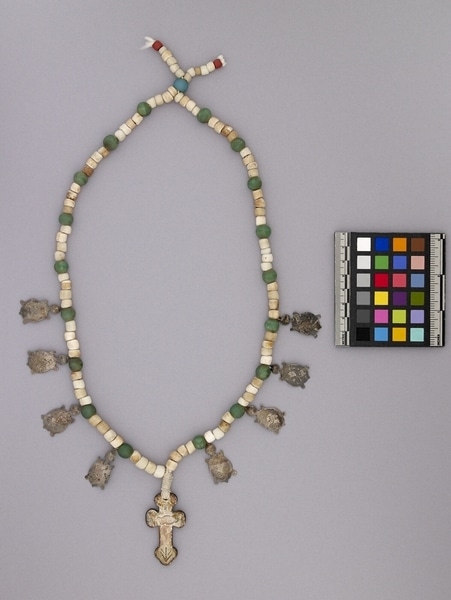Necklace Item Number: 1590/279 from the MOA: University of British Columbia

Description
Necklace with 90 glass beads, 18 green glass beads, one blue bead, 2 red and black cylindrical beads, 8 flat turtles and one thick Latin cross with short cross bar and rounded ends. Turtles have cross-hatched engraving and the Jost hallmark. Cross is also engraved and has a stamp 'Boyer' on it. Necklace is threaded on string.
History Of Use
Silver ornaments represent an important part of early exchange between Europeans, including fur traders, and First Nations peoples, especially in eastern and central Canada and the U.S.A. Initially, the main source of silver was British, French and Spanish coins. Most ornaments were produced by silversmiths of European origin in North America and Europe, and were actively traded only from 1760 to 1821. By the mid-18th century silver objects were produced in New England, Quebec and Montreal. Silver was used by First Nations peoples as a sign of rank. Silver ornaments in these styles continue to be produced by native silversmiths in central Canada and the U.S.A.
The cross was the oldest form of trade silver, introduced by French missionaries to North America for presentation to converts. Crosses were later used as trade silver with no religious connotations. They circulated well into the 19th century and were worn on the chest. The Latin cross has a single bar.
Animal imagery is a significant part of Woodland First Nations tradition, but no documented instance has been found of the use of animal effigies in trade. The place of effigies in Woodlands culture is not known. The Iroquois legend of the turtle explains that the earth was formed from a lump of mud on the turtle’s back. See Frederickson, page 59.
Cultural Context
trade; personal decoration; status
Narrative
Jost pieces likely made in New York, however Boyer (cross maker) is said to have worked in Boston.
Item History
- Made by Daniel Boyer (Maker) and Jost (Maker) in New York, New York, USA ? between 1760 and 1821
- Owned by Kathleen E. Reif before September 9, 1993
- Received from Kathleen E. Reif (Donor) on September 9, 1993
What
Who
- Culture
- Eastern Woodlands
- Creator
- Daniel Boyer (Maker) and Jost (Maker)
- Previous Owner
- Kathleen E. Reif
- Received from
- Kathleen E. Reif (Donor)
Where
- Holding Institution
- MOA: University of British Columbia
- Made in
- New York, New York, USA ?
When
- Creation Date
- between 1760 and 1821
- Ownership Date
- before September 9, 1993
- Acquisition Date
- on September 9, 1993
Other
- Item Classes
- metalwork
- Condition
- good
- Current Location
- Case 45
- Accession Number
- 1590/0279